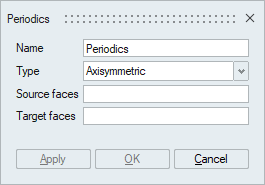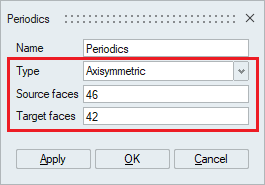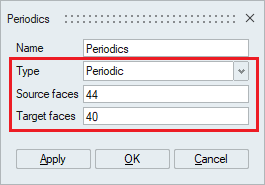Periodics
![]()
The periodic boundary condition is used to define a cyclic/repeating condition of flow across the boundary face. For this condition, it is mandatory to select two boundary faces (Source and Target) that will be treated as if they are physically connected (nodal pairs). The flow entering/exiting from one face then exits/enters the other face. The flux across the two faces will be the same in magnitude but opposite in direction.
Generally, this boundary condition is used to approximate infinitely long domains into smaller ones.
- The two faces (Source and Target) need to be of same size and shape.
- The surface mesh on the two faces need to be congruent (mirror image of another).
- Periodic boundary conditions can only be applied on faces having identical mesh.
To obtain identical surface mesh on both face, symmetry mesh control needs to be used for surface meshing.

Description
- Type
- Axisymmetric
If a body is symmetric about an axis, then an axisymmetric periodic boundary condition can be applied. It specifies that a vector field of two nodes be equal in a rotated coordinate system defined by an axis of rotation. The rotation of axis is automatically calculated based on the source and target faces.


- Periodic
This is used for translationally periodic boundaries, enabling to model a fully developed periodic flow.

- Axisymmetric